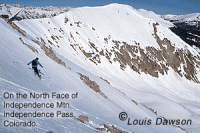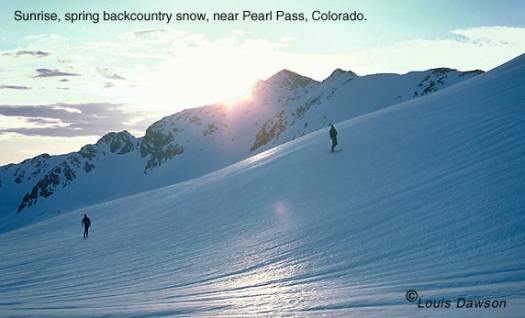By Louis Dawson
When they click off the big red switch on most Colorado ski lifts, here at WildSnow.com that’s the signal for the best glisse of the year. During winter, Colorado backcountry snow is a frozen wave, set in motion as fearful avalanches by nothing more than the punch of an elk’s hoof or the cut of a skier’s edges. Come spring the snow compacts under its weight like a fallen cake. Combine this denser snowpack with a daily rhythm of freeze and thaw, and spring avalanche danger is easy to predict and avoid. Just ski or snowboard in the morning after a cold clear night and you’re eliminating almost all avalanche hazard. What’s more, the springtime snow surface is a matrix of jumbo crystals known as corn-snow. Billiard table smooth and easier to ski than the finest groom, corn is the best snow on the planet. But wait, perfect snow begs for grand terrain. Where to find it? Look no farther than Colorado.
As if ripped by a gigantic claw, the Colorado Rocky Mountains are cleaved with thousands of basins, clefts and aretes — a nirvana for adventure skiers. The key is to get high. Above the trees, an infinity of legendary ski and snowboard descents await your edges.
Pick any spring morning after a clear night and drive to a high trailhead. Your path might begin on ground where the snow melted only hours ago, showing sprigs of grass fighting their way through last autumn’s stalks. It’s a land of water. The source for summer’s growth stored in a mountain snowpack; released in rations for those below. Snow is life. Water for thirsty plants–and life for your skis.
Starting before dawn, the yellow pool of your headlamp seals you in a meditative world focused on the crunch of your boots and pant of your breathing. Cold air falls down the valley you climb. With such wind in your face you smell the cold-steel balm of white wilderness above. At first light, when alpenglow fires the high summits with radiance like the burn of a gigantic campfire, the dusty surface of the old snowpack glows with erie luster.
You kneel and feel the frozen spring corn snow. It scraps your palm like 30-grit sandpaper. The stuff has personality. Slake your thirst with a chunk; taste flinty rock scourged off a high ridge by winter’s wind, set off with bouquet of spruce from the forest below.
Spring backcountry skiing is about connections–about kinship–fusion with the planet under your skis and with creation around you. You’re the human animal; your nose flares with a scent on the wind; your eyes scan; your ears pull every sound. You are melded to the earth with a prehistoric tool invented more than five thousand years ago.

Splitboard skis up and rides down.
As your awareness broadens with the day you climb to the sharp line of the rising sun– then farther–until all around you is down. You’d like to stay forever but gravity is hungry. You feed it and ski. Firm corn snow holds your planks in an arc that man-made groom hardly imitates. As you fall into the first kiss with a lover, so your carving edge blends with gravity as a primal touch throbs from your toes to the back of your neck. You pump turn after exuberant turn. Cold morning air freezes a grin on your face. When you finally stop, gasping for breath, you laugh with your friends and agree: If creation reveals the creator, he must have had us humans in mind when he invented snow.
Colorado Spring Backcountry Ski & Board Resources
Your most important strategy for Colorado spring backcountry skiing is to access the highlands as quickly and efficiently as possible. In later spring, the best (and possibly only) good skiing will be at timberline and above (though you can get a “faux spring snowpack” below timberline during big snow years or with ideal conditions). Access the heights by using ski lifts such as those at Arapaho Basin, roads such as Loveland Pass, Cameron Pass and bountiful Red Mountain Pass, or simply hike or 4-wheel to snowline from as high a trailhead as you can find. Following are ideas for specific adventures, biased towards the Western Slope because that’s the land I know best.
A good place to learn about spring backcountry skiing is Independence Pass on Highway 82 east of Aspen. Here, after the highway department opens the road around Memorial Day, you can park at 12,093 feet in the midst of the spring snowpack. Time your drive so you arrive just before first light, then strike north on mellow terrain for a mile or so of touring. If you want something steeper, keep going and climb the continental divide to the summit of Blue Peak. Click in and swoop the corn back to your tailgate. Another trip for backcountry tyros with expert downhill skills is to hike Snowfence Ridge for about 1 1/2 miles southwest of the pass, then drop east down an elegant shoulder into Mountain Boy Gulch. The trick with this route is to park a car at the your end-point on the road (usually the second switchback down the east-slope side of the pass). I’ve seen a half dozen pick-up trucks parked here on a spring morning, waiting for loads of starry eyed adventure riders and skiers. No mention of Independence is complete without Fourth Of July Bowl. Named for the Independence ghost town, (or perhaps because it holds snow in to the summer), Fourth of July is the big flank and bowl on your right before you drive the final switchback up the west side of the pass. You access it by parking at the pass, then doing a short hump west over the lower part of Snowfence Ridge. Fourth of July is often too crowded for my taste, but it’s a good starter that will get you lusting for more.
Grizzly Peak is the Independence Pass classic. A favorite of old time Aspenites such as Bil [this is correct spelling] Dunaway and the late Fritz Stammberger, Grizzly is where I learned to love the steeps, to love corn, and to love the feeling of almost flying when you launch a jump-turn in a 45 degree couloir.
Grizzly is 13,988 feet high: just shy of membership in Colorado’s elite cadre of fifty four 14,000-foot peaks. No problem. Stand on the summit cairn, raise a ski pole, and you’ve made Grizzly Peak a “fourteener.” Skiing from 14,000 feet is a special treat: runs are longer, snow lasts longer. Just the climb is totally satisfying–the skiing a special reward. You stand on the summit with the world dropping away in a gut wrenching view. You know the Grizzly Chute couloir is steep; but you’ve got the skill and the gear to take it. Your palms sweat anyway but you push off with your ski poles. The first turn’s the one–you make it and the rest follow in a cadence like an eagle’s wingbeat. You and the mountain ski together–you’ve made the connection. Spring backcountry skiing. Yes!
You can find plenty of accessible spring skiing around the Roaring Fork Valley (Aspen, Glenwood Springs, Carbondale). Approach slogs vary from muddy hikes to tailgate-to-tailgate perfection, and the vagaries of road closures change access yearly. For major ascents, it’s a good idea to check road access the day before. You want to earn your turns, but too many surprises can make the price too high. Up Castle Creek, famous Hayden Peak awaits your edges. Here Andre Roch proposed Aspen’s first ski area. Ski it and know why.
A few ridges west, and Maroon Creek leads to the extreme skier’s paradise of the Maroon Bells. Testosterone poisoning to some — elegance to others — here you can test the limits of extreme skiing and snowboarding. Farther downvalley, you can get awesome terrain by driving up the Fryingpan Road from Basalt, then taking Road #505 to the Fryingpan Lakes Trailhead. Here 14,421 foot Mount Massive sits in regal splendor, lording over dozens of other classic aretes and bowls of corn snow. Rising southeast of Carbondale, Mount Sopris dominates the valley. All the Sopris bowls yield sublime spring skiing. Behind Mount Sopris, the Yule Quarry road from Marble gets you to the base of several splendid bowls. While below timberline, these may yield good corn-snow when the higher peaks are still cloaked in winter snow. (Hint, skiing the roadside attractions off Quarry Road gives you a jump on spring skiing)
One caveat: all these suggestions are best skied with a compacted spring snowpack. With winter snow they’re avalanche death traps. How to tell the difference? Ski with a guide or knowledgeable friend, and take an avalanche awareness course.
For detailed information about many spring skiing routes in the greater Aspen area and Elk Mountains of Colorado, please check out BackcountrySkiingCo.com
WildSnow.com publisher emeritus and founder Lou (Louis Dawson) has a 50+ years career in climbing, backcountry skiing and ski mountaineering. He was the first person in history to ski down all 54 Colorado 14,000-foot peaks, has authored numerous books about about backcountry skiing, and has skied from the summit of Denali in Alaska, North America’s highest mountain.


